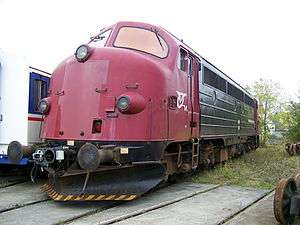Bulldog nose

"Bulldog nose" is the nickname given, due to their appearance, to several diesel locomotives manufactured by GM-EMD and its licencees from 1939 to 1970. The term originated with EMD F-units, as well as later E-unit models such as the E7, E8, and E9.
Clyde derivatives
In 1951 the EMD F7 series was modified by General Motors' Australian licence holder Clyde Engineering to fit Australian loading gauge and axle load constraints.[1] The 1,500 hp (1,100 kW) A1A-A1A Clyde/EMD ML1 locomotive was introduced on the Commonwealth Railways as the GM class, as well as exported to Pakistan.[2] It was further developed into the ML2 as a dual cab Co-Co locomotive, with a bulldog nose at each end, for Victorian Railways becoming that system's B class.[3] A single-nose variant of the design, the EMD A7, with the revised 1,800 hp (1,300 kW) EMD 567C series engine was introduced as the NSWGR 42 class, VR S class, and an upgraded CR GM class. The design continued to be developed with the dual-cab EMD AJ16C, introduced on NSWGR as the 421 class, although unlike the earlier ML2 the bulldog nose was only used on one end of these locomotives.[4] 1970 saw the introduction of the last new locomotive design in the world to utilise the F-series bulldog nose, the 3,000 hp (2,200 kW) EMD AT26C, introduced on the Commonwealth Railways as the CL class.[5][6] A final Australian iteration of the bulldog nose in Australian locomotive practice was the rebuild of the 30-year-old Victorian ML2 units into the EMD AAT22C-2R, introduced as the V/Line A class.[3]
The NOHAB bulldog

There were also a number of European "bulldog nose" locomotive classes, all of which were built by NOHAB or AFB (with license from EMD), also frequently referred to as "round noses". These were effectively Clyde's ML2 design modified to meet European clearance standards, and had a lower nose and deeper cab windows.[7]
The NOHAB-built classes include the DSB's class MY/MV and MX, the NSB's class Di3 and the MÁV class M61; NOHAB's design was later used by AFB, which built the NMBS/SNCB's class 52-54 and the CFL's class 1600.
Other such locomotives
The SJ Class Ra (or Rapid) is an electric locomotive operated until 1996 by Statens Järnvägar of Sweden. Ten units were built by ASEA, two in 1955 and eight in 1961. Ra was used on express trains until the 1990s. In India, the railways used electric locos in the WCM series on its DC electricity lines in Maharashtra. WCM locos type 1 to 5 had bulldog noses. Type 6 hade a different style.
References

- ↑ Oberg, Leon (2007). Locomotives of Australia 1854-2007. Rosenberg Publishing. p. 250. ISBN 1-877058-54-8.
- ↑ Oberg, p. 251
- 1 2 Oberg, p.264
- ↑ "SRA: 421 Class". 2007-09-05. Retrieved 2008-06-07.
- ↑ Oberg, p.360
- ↑ "AN: CL Class:". 2007-09-05. Retrieved 2008-06-07.
- ↑ "NOHAB-GM Foundation - Worldwide Historic Overview". 2006-01-10. Retrieved 2008-06-07.
External links
- Andrew Toppan's list of surviving EMD E-units
- Gallery of NOHAB-GM diesel locomotives by P. Matsson
- Diesel locomotives built by NOHAB and AFB by Armand Schmit
- Wouter's Train Page by Wouter Radstake — pictures of both American and European "bulldog noses"

